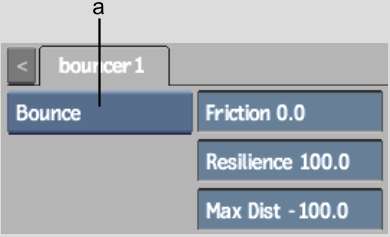You can bounce a particle stream off either an image or a bouncer. When particles bounce off an image, they bounce off the surface wherever its matte is white or grey. Particles only pass through the areas of the image where its matte is pure black. If a surface's matte is turned off, particles bounce off the entire surface.
When you use a bouncer, it must be the parent of an axis or a light source. A bouncer shows up as a sphere in the Action scene when you use it with a light source. Otherwise, all other types of surfaces create flat bouncers.
Whether you use a bouncer or an image, bouncing particles are controlled using the Particle Bouncer menu.



(a) Bounce Type box
Bounce Type boxSelects the type of bounce. There are four types of bouncing that you can perform.
| Select: | To: |
|---|---|
| Bounce | Bounce particles off images or bouncers. All bounce properties work with this type of bounce behaviour. |
| Extinct | Make particles disappear when they reach a surface. Only the Max Dist parameter works with this type of bounce. |
| Generator | Create an additional particle stream when particles bounce. When using this bouncing behaviour, you must add another particle generator. See Combining Particle Streams. |
| Generator+ Extinct | Make particles disappear and create an additional particle stream when particles reach a parented surface. Only the Max Dist parameter works with this type of bounce unless the particles end in another particle stream. See Combining Particle Streams. |
Friction fieldFriction is a percentage that influences the angle of bouncing particles. The greater the percentage, the more particles bounce straight. For example, in the left figure, Friction is set to 100%, which bounces particles almost perfectly straight. In the figure on the right, Friction is set to 20%, which causes the particles to deviate once they make contact (bounce).
Resilience fieldResilience determines the amount of energy kept with each bounce. For example, at a Resilience of 100%, the figure on the left shows there is no energy lost between bounces. Each bounce is at the same height as the last bounce. When Resilience is set to 80%, 20% of energy is lost between each bounce. At 50%, the figure on the right shows the height of each bounce is reduced by 50%. Note that Friction is set to 0 for both examples.
Max Dist fieldSpecifies the maximum distance a particle travels past an image for it to still bounce or become extinct.
Because an image is only a pixel in width, it is unlikely that fast moving particles will hit the image directly. Max Dist acts like a buffer zone after the surface. If particles fall through the surface, set the Max Dist to -100. Particles that miss the surface by 100 pixels will still bounce.
If particles still fall through the surface, increase the timestep to increase the accuracy of the particle stream.